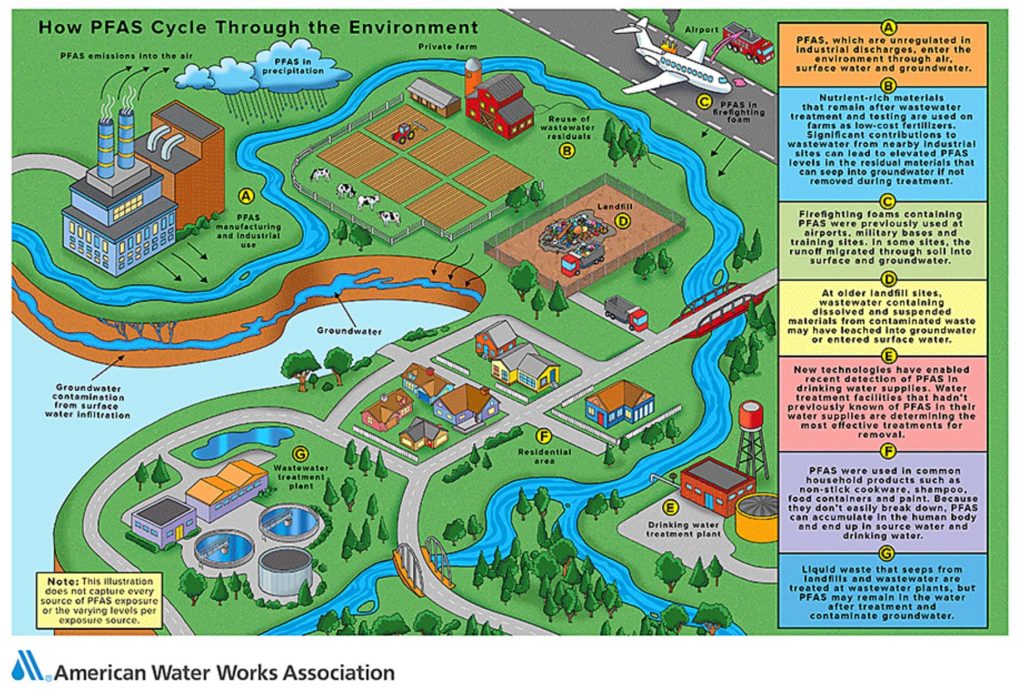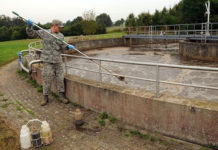
Environmental Destruction is Part of the Huge Human Costs of the American Military Empire
Whenever I read or hear about PFAS in the news it always seems to be about contaminated drinking water. That’s because the federal government and the U.S. military prefer talking about PFAS in municipal water systems where the problem is being resolved. They don’t want to address the environmental disaster and public health crisis caused by these chemicals in our surface water and groundwater.
“PFAS” are per-and poly fluoroalkyl substances and they’re bad news.
In 2016 the EPA established a health advisory for PFOS & PFOA in drinking water at 70 parts per trillion. At the time, the EPA recognized that the dominant source of human exposure to PFAS is primarily from the diet and other sources like indoor dust from carpets. The health advisory was calculated using a contribution of 20% for the water, which allows for PFAS exposure from other sources to make up the additional 80% exposure.

The European Food Safety Authority estimates that 86% of the PFAS in our bodies comes from food, especially seafood caught from contaminated waters. When we allow for the carpets and the dust and the frying pans, this doesn’t leave much of a slice of the pie for municipal water, which, in the case of Brunswick, is reported to be PFAS free.
It’s not so much the drinking water! Instead, it’s the fish and the mussels and pretty much everything we eat from the rivers and the sea that are making us sick.
For more than 40 years, the Navy recklessly discarded thousands of gallons of toxic firefighting foam into the ground in Brunswick. This region will suffer the consequences for a millennium—and perhaps forever.

PFAS are pesky poisons. They never break down and they accumulate in us. They’re linked to several cancers and they profoundly affect the developing fetus. Think: ADHD, obesity, hypertension, hypothyroidism and gastroenteritis in children. PFAS is associated with delayed menarche and mammary gland development. Experts say ingesting as little as 1 ppt of these chemicals in drinking water may be dangerous.
Groundwater
The DOD reported that groundwater at the former Naval Air Station Brunswick was contaminated with concentrations of PFOS at 24,000 ppt and PFOA at 15,000 ppt. Combined, that’s 39,000 ppt.

In June 2021, the Maine Legislature established a new interim state drinking water standard of 20 ppt for the combined sum of six different PFAS: PFOA, PFOS, PFHpA, PFNA, PFDA, and PFHxS. The groundwater coming out of the base is 1,950 times over the limit.
People who drink from wells near military bases are in peril. Although PFOS plumes are known to travel many miles, the DOD says it recently sent notifications to ten agricultural operations within one mile of the former Brunswick installation, warning of the contamination in groundwater.

Surface Water

The public ought to be attending these
online meetings and ask questions.
Groundwater seeps into surface water and that’s where we get into trouble with the mussels and the fish. The Navy reported during a Restoration Advisory Board (RAB) Meeting on July 21, 2021, that water from a storm drain at the airfield contained concentrations of 8,260 ppt of PFOS and 339 ppt of PFOA. The Navy is known to drag its feet on publishing the minutes from RAB Meetings—so the minutes to the July 21 meeting are still not online.
PFOS bioaccumulate in seafood—like mussels. The tiniest amounts in the water may translate to levels thousands of times higher in seafood tissue.
The European Union considers PFOS as a priority hazardous substance under the EU Water Framework Directive. The European Environmental Quality Standard limit value is .65 ppt for inland surface waters. The Wisconsin Department of the Environment says more than 2 ppt of PFOS in surface water is a threat to human health. Brunswick has 8,260 ppt in surface waters near the airfield.
What about the Mussels?
In 2020 two mussels found at the mouth of Mere Creek where it empties into Harpswell Cove were tested by David S. Page of the Brunswick Area Citizens for a Safe Environment, (BASCE.). Harpswell Cove receives water from Mere Creek which drains the former Naval Air Station Brunswick.
Here are the results of that study in parts per trillion, (ppt)
| Compound | Mussel 1 | Mussel 2 |
| PFBA | 4,730 | 4,530 |
| PFBS | 140 | 220 |
| PFOS | 5,630 | 7,270 |
| Total PFAS | 10,500 | 12,020 |
PFBA (Per fluoro butanoate); PFOS (Per fluoro octane sulfonate); PFBS (Per fluoro butane sulfonic acid).
The state of Maine tested mussels from Harpswell Cove in 2014 and 2016 and found PFAS levels up to 5,320 ppt.
In July, Maine adopted a law that will ban PFAS in products, like food packaging. The state, however, has not moved to regulate the food in that packaging – and that brings us back to the mussels.
We have to look to the Europeans for guidance. The European Food Safety Authority (EFSA) has set a Tolerable Weekly Intake of 4.4 nanograms per kilogram of body weight for PFOS (and several other PFAS) in food.
So, according to this guideline, an expectant mom weighing 150 pounds (67.8 kilos) can “safely” consume about 300 nanograms per week of PFAS chemicals. (4.4 ng x 67.8 kg = 298.32).
We’ll say mom consumes an 8-ounce serving or 227 grams of the mussels.
If a serving of Brunswick mussel meat contains 7,270 ppt, that’s 7.27 parts per billion, which is the same as 7.27 nanograms per gram. So, 7.27 ng/g x 227 g = 1,650 ng of PFOS.
Sorry about all that math.
In one sitting, pregnant mom consumes 1,650 nanograms of the carcinogens, which is 5.5 times more than the European weekly limit. A Brook Trout had concentrations of 1,080,000 ppt of PFOS in a stream near Loring Air Force Base, where fire-fighting foams, like those in Brunswick, were carelessly used for years. The Loring Trout is 150 times more poisonous than our Brunswick mussels.
See this spreadsheet of PFAS in 24 fish throughout Maine from data provided by the EPA and the state of Maine. A softshell clam from Broad Cove in Eastport had concentrations of 7,645 for PFAS, which was also the median of the brief dataset.
Almost all of the attention given to PFAS in the media is focused on levels of the toxins in drinking water, while few address the seafood. What’s in your fish?

CovertAction Magazine is made possible by subscriptions, orders and donations from readers like you.
Blow the Whistle on U.S. Imperialism
Click the whistle and donate
When you donate to CovertAction Magazine, you are supporting investigative journalism. Your contributions go directly to supporting the development, production, editing, and dissemination of the Magazine.
CovertAction Magazine does not receive corporate or government sponsorship. Yet, we hold a steadfast commitment to providing compensation for writers, editorial and technical support. Your support helps facilitate this compensation as well as increase the caliber of this work.
Please make a donation by clicking on the donate logo above and enter the amount and your credit or debit card information.
CovertAction Institute, Inc. (CAI) is a 501(c)(3) non-profit organization and your gift is tax-deductible for federal income purposes. CAI’s tax-exempt ID number is 87-2461683.
We sincerely thank you for your support.
Disclaimer: The contents of this article are the sole responsibility of the author(s). CovertAction Institute, Inc. (CAI), including its Board of Directors (BD), Editorial Board (EB), Advisory Board (AB), staff, volunteers and its projects (including CovertAction Magazine) are not responsible for any inaccurate or incorrect statement in this article. This article also does not necessarily represent the views the BD, the EB, the AB, staff, volunteers, or any members of its projects.
Differing viewpoints: CAM publishes articles with differing viewpoints in an effort to nurture vibrant debate and thoughtful critical analysis. Feel free to comment on the articles in the comment section and/or send your letters to the Editors, which we will publish in the Letters column.
Copyrighted Material: This web site may contain copyrighted material the use of which has not always been specifically authorized by the copyright owner. As a not-for-profit charitable organization incorporated in the State of New York, we are making such material available in an effort to advance the understanding of humanity’s problems and hopefully to help find solutions for those problems. We believe this constitutes a ‘fair use’ of any such copyrighted material as provided for in section 107 of the US Copyright Law. You can read more about ‘fair use’ and US Copyright Law at the Legal Information Institute of Cornell Law School.
Republishing: CovertAction Magazine (CAM) grants permission to cross-post CAM articles on not-for-profit community internet sites as long as the source is acknowledged together with a hyperlink to the original CovertAction Magazine article. Also, kindly let us know at info@CovertActionMagazine.com. For publication of CAM articles in print or other forms including commercial internet sites, contact: info@CovertActionMagazine.com.
By using this site, you agree to these terms above.
About the Author

Pat Elder is a peace and environmental activist who has run for Congress on the Green Party ticket in Southern Maryland.
He can be reached at: pelder@militarypoisons.org.









And once again I believe the autocrats at Glasgow did not take military carbon emissions into account. Thank you very much, Pat Elder, for this excellent article. I live in Maine and we OCCASIONALLY eat mussels, but we do eat other seafood from the Gulf of Maine. I am so disgusted by human idiocy that I look forward to my last days on this beautiful planet; at least I’ll be free of my species.
The institution that dumps the most carbon into the upper atmosphere is the military. This is true everywhere there are military exercises or, certainly, wars. The US is the worst offender.